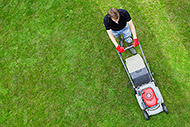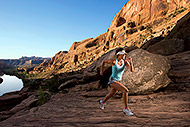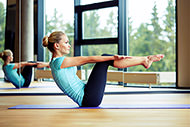
As the weather improves, it’s time to add variety to your fitness routine by moving your workouts outside. Here are tips to keep your workouts safe and effective.
Stay hydrated.
The heat, humidity, and increased sweating make dehydration a greater risk during outdoor activities. Hiking, long runs, and bike rides can also take you further from a water source. Hydration needs vary from person to person, but the American College of Sports Medicine (ACSM) offers general guidelines for fluid intake . Drink 16-20 ounces at least four hours before exercise, and drink 8-12 ounces 10-15 minutes before exercise. During exercise, drink 3-8 ounces every 15-20 minutes. After your workout, drink 20-24 ounces of fluid for every pound lost. A sports beverage may be necessary during exercise for durations over 60 minutes. The ACSM recommends not exceeding one quart of fluid per hour during exercise.
Dress for exercise success.
Moisture-wicking clothing is essential for outdoor exercise, whether the conditions are cool, hot, or humid. Unlike cotton, which can trap heat and moisture, moisture-wicking fabrics keep you dry and cool, reducing the risk of overheating. From shirts and shorts to hats and socks, be sure you have the clothing you need to perform well during your workout.
Protect yourself.
Outdoor exercise requires sunscreen to protect your skin from sun damage. Look for sweatproof varieties that are designed for outdoor exercise. The American Academy of Dermatology recommends a broad-spectrum sunscreen with a sun protection factor (SPF) of 30 or greater. Cover all exposed skin, and don’t forget sunscreen for your lips and scalp.
Assess your footwear.
Depending on the type of exercise you choose, your footwear requirements may change when transitioning from indoor to outdoor exercise. For example, hiking and trail running require sturdy shoes for extra stability and traction.
Take it slow.
Outdoor activities can be more challenging than gym workouts. Hills, rough terrain, wind, and warmer temperatures can make even a simple walk more difficult. Don't get discouraged if you struggle to complete the same distance once you are outside. Do what you can, and gradually increase the time and intensity each week until you reach your goals.
Sources



 5 Ways to Burn 300 Calories this Weekend
5 Ways to Burn 300 Calories this Weekend
 The Best Home and Garden Chores for Burning Calories
The Best Home and Garden Chores for Burning Calories
 5 Tips for Making Exercise a Habit
5 Tips for Making Exercise a Habit
 Best Ways to Stay Safe during Exercise in Hot Weather
Best Ways to Stay Safe during Exercise in Hot Weather
 11 Tips for Exercise Motivation
11 Tips for Exercise Motivation
 Signs You Need to Increase Exercise Intensity
Signs You Need to Increase Exercise Intensity
 Common Exercise Myths
Common Exercise Myths
 How to Gradually Increase Physical Activity
How to Gradually Increase Physical Activity

 Pinterest
Pinterest RSS Feed
RSS Feed